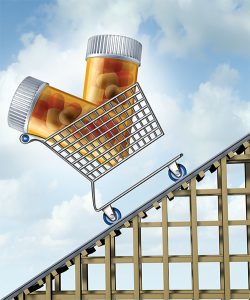
Lightspring/shutterstock.com
LONDON—The availability of a biosimilar form of infliximab has dramatically increased the number of Norwegians taking one form or another of the drug, an expert on biosimilars said in a debate-style session at the Annual Congress of the European League Against Rheumatism (EULAR 2016).
The expanded uptake of Remicade (infliximab) and its biosimilar, Remsima (international non-proprietary name: infliximab), in Norway and elsewhere in Scandinavia is a striking illustration of the impact that newfound affordability of a drug can have in meeting the needs of patients, said Tore Kvien, MD, head of rheumatology at the University of Oslo and Diakonhjemmet Hospital.
On the flip side, Ronald van Vollenhoven, MD, PhD, director of the Amsterdam Rheumatology and Immunology Center, said there could be a downside to biosimilars if less money is spent on research and development and if regulatory oversight can’t keep up with the increase in manufacturing.
Dr. Kvien argued that biosimilars “could potentially improve accessibility to good therapies for more people with rheumatic and musculoskeletal diseases. For me, that really is the main idea.”
Overcoming the Cost Barrier
Access to disease-modifying drugs is a problem, especially in countries with lower incomes, according to a study of countries in Europe published in 2014.1
Biosimilars are a potential solution. Nationally collected data show that Remsima was the cheapest tumor necrosis factor inhibitor in that country in 2014, costing 39% less than Remicade. In 2015, the difference was even greater, with Remsima costing 69% less.
Norway has a national “tender system” in which drug companies offer a price for their products and a committee determines the annual cost for various indications. This calculation is a key driving factor in which drugs are prescribed and used by patients.
“If you compare for rheumatoid arthritis, we could treat five patients with Remsima for the same cost as one patient with [Remicade],” Dr. Kvien said.
Acceptance in Scandinavia
Beginning in 2014, when Remsima became available, prescriptions for the biosimilar began to outpace those for Remicade. And the outpacing was even greater in 2015. Remsima now has between 80 and 90% of the market share, Dr. Kvien said.
Prescribing of Remsima has not been as dramatic everywhere in Scandinavia. In Sweden, which has different pharmaceutical financial mechanisms, the uptake has been much lower. But in Denmark—where use of the biosimilar became mandatory in 2015—uptake has been even greater than in Norway, Dr. Kvien said.
Also in Denmark, total infliximab prescriptions leaped from 7,000 in 2014 to a total of about 14,000—the originator and the biosimilar combined—by the end of 2015. In Norway, the total number of prescriptions jumped from about 7,000 to about 13,000 over that period.
There could be a downside to biosimilars if less money is spent on research & development & if regulatory oversight can’t keep up with the increase in manufacturing.
In the Pipeline
More biosimilars are on the way: Data have been presented or published on nearly 20 biosimilars for rheumatic diseases, a 2016 study found.2
“This is just the beginning of an explosion of biosimilars,” Dr. Kvien said. “So if people are saying, ‘I’m against biosimilars, then you are against something that will happen in the future.”
But Dr. van Vollenhoven said the rise of biosimilars is not simply a movement that will advance unabated and cannot be stopped. Rather, he said, the development of biosimilars should be undertaken with some realization of the potential downsides.
Just 20 years ago, he reminded the audience, treatment for rheumatoid arthritis worked well for some patients, but for many others, they did not work well at all. Now, there are drugs available that span five mechanisms of action and “only rarely is a patient doing outright terribly badly.”
These advancements have come because of great investments by pharmaceutical companies in research and development. And the only reason that biosimilars cost less than their originator drugs is that less money has been spent on the research and development that has led to the biosimilars’ approval.
With the arrival of biosimilars, “research and development will be less. In the end, that’s where the money comes from, nowhere else.”
He said the lower cost and the expanded accessibility of biosimilars is something to be cheered, but added, “I have to honestly say that I have been surprised a little bit by how excessive the cheering has been in some rheumatology circles.”
He also expressed concern that, with so many biosimilars being made, regulators will be hard pressed to stay on top of the manufacturing process, raising the possibility of problems with the final product.
“I’m a little bit worried that if the production of these medications is going to be taking place in so many different places in so many different plants, who’s actually keeping an eye on this?” he said. “I haven’t seen that the EMA [European Medicines Agency] has a quadrupled budget for monitoring and overseeing this.”
Dr. van Vollenhoven’s comments stirred some controversy. One audience member said that he failed to draw a distinction between biosimilars—well-understood and well-characterized drugs—and so-called “bio-mimics” from far away, unregulated manufacturing plants.
Arnold Vulto, PharmD, PhD, professor of hospital pharmacy at Erasmus University Medical Center, said the system on biosimilar manufacturing has been refined over time, and that changes to the manufacturing process now have to be well documented. He also said the advent of biosimilars has tended to open up the knowledge of how these pharmaceuticals work and are made.
“I have learned a lot more from biosimilar companies by now than originators ever taught me,” he said. “So I think that’s a great advantage to the medical community.”
Thomas R. Collins is a freelance medical writer based in Florida.
References
- Putrik P, Ramiro S, Kvien TK, et al. Inequities in access to biologic and synthetic DMARDs across 46 European countries. Ann Rheum Dis. 2014 Jan;73(1):198–206.
- Dorner T, Strand V, Cornes P, et al. The changing landscape of biosimilars in rheumatology. Ann Rheum Dis. 2016 Jun;75(6):974–982.

